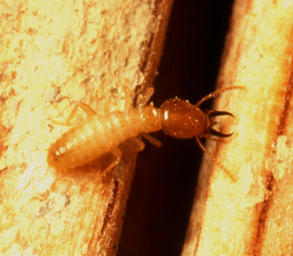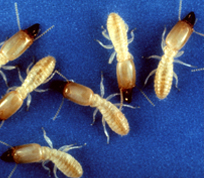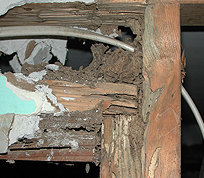Subterranean TermitesFebruary Pest of the Month.

What are Subterranean Termites & what causes them?
Subterranean termites are social and live in colonies and are by far one of the most destructive termites. Those colonies are composed of workers, soldiers and reproductive kind of like ants and can contain up to 2 million termites. Subterranean termites often have large swarms from January through May. Smaller swarms can occur throughout the summer and fall months. (photo to the left courtesy of: USDAGov on Flickr, Photographer: Scott Bauer)
Eastern subterranean termites often have large swarms from January through May. Smaller swarms can occur throughout the summer and fall months. These eastern subterranean termite infestations and big colonies can collapse a building; their hard, saw toothed jaws allow termites to bite off small pieces of wood, one piece at a time.
Jump to section: Information | Symptoms | Habitat | Treatment | More Information
General Information
 There are three types of termites that reside in Florida and the most destructive and most encountered kind found throughout North Central Florida is the eastern subterranean termite. They are called subterranean termites because they nest in the soil. According to the University of Florida they can attack structures by building tubes that connect their nest to wood in structures. On average each colony has an average of 300,000 termites and the queen can add 5,000 to 10,000 eggs a year!
There are three types of termites that reside in Florida and the most destructive and most encountered kind found throughout North Central Florida is the eastern subterranean termite. They are called subterranean termites because they nest in the soil. According to the University of Florida they can attack structures by building tubes that connect their nest to wood in structures. On average each colony has an average of 300,000 termites and the queen can add 5,000 to 10,000 eggs a year!
Also listen to recorded radio interviews with Roy Crain Jr. discussing this month's pest.
Symptoms
Termites are often hard to spot and detect; however, you may be able to see a winged reproductive termite, mud tubes and wood damage when dealing with eastern subterranean termites.
-
Swarming Eastern Subterranean Termite Videos
-
Eastern Subterranean Termite Winged Reproductive
The winged eastern subterranean termite reproductives are usually swarming or seen during the springtime and during daylight. This is usually the first thing someone sees when they have a termite problem. They are easily distinguished from flying ants by their thick waist, straight antennae and wings of equal size (UF). Their wings break off after flying. Seeing these wings laying around is another indication of a termite colony nearby.
-
Eastern Subterranean Termite Mud Tubes
Mud tubes are built by eastern subterranean termites to protect them from low humidity and predators. Mud tubes are usually 1/4"to 1" wide. Termites use these mud tubes to get food and for protection from open air.
-
Wood Damage
Wood damage by subterranean termites can often go unnoticed because you must remove the exterior wood to see the damage caused by these pests. Wood damage by termites can also be found by tapping the wood every few inches with a screw driver; if it sounds hollow or if the screwdriver breaks through the wood there may be a termite infestation. Unlike other termites, subterranean termites do not push wood particles or pellets to the outside since they use it for building their tunnels (UF).
If your house is on a concrete slab, cracks in the slab and places where pipes and utilities go through should be examined for mud tubes. Cracks in a concrete foundation and concrete blocks can be entries for subterranean termites.
Habitat
 Termites are attracted to the light. Eastern subterranean termites feed on wood and other items that contain cellulose. Sometimes they feed on the roots of shrubs or trees (Termidor). They nest in the soil to obtain moisture and nest in wood that is often wet. Subterranean termites often attack wood that is attached to the ground. If the structure is not on the ground, subterranean termites can build a mud tube in excess of 50-60 feet above ground to reach the wood and attack cracks and crevices within the dwelling to enter the house (UF).
Termites are attracted to the light. Eastern subterranean termites feed on wood and other items that contain cellulose. Sometimes they feed on the roots of shrubs or trees (Termidor). They nest in the soil to obtain moisture and nest in wood that is often wet. Subterranean termites often attack wood that is attached to the ground. If the structure is not on the ground, subterranean termites can build a mud tube in excess of 50-60 feet above ground to reach the wood and attack cracks and crevices within the dwelling to enter the house (UF).
Once a termite colony is built, reproductive subterranean termites will go off and find a new place to start new colonies. In order for termites to survive they need contact with the soil (NPMA). Subterranean termites often have more than one colony in a single building (Termidor).
- Eastern subterranean termites are found in all states in the United States except for Alaska. (They are relatively scarce in the colder states.)
- They are predominately located in the humid, sub-tropical areas between Florida and Texas) as well as Utah and California.
- Eastern subterranean termites prefer to eat soft, spring wood fiber and they only leave the grain from wood behind.
- These termites destroy structures by eating wood from the inside out.
- Fact: it's estimated that more than one in five homes listed in the high-risk areas (almost the entire state of Florida) will be attacked at some point in time by these pests (Termite.com).
Life Cycle
A newly hatched termite can develop into any of the following castes. Generally, they begin in the working caste and are likely to remain so for their-entire life. Molting (morphing) can occur and change the worker into a soldier. Once a soldier termite is classified as this it can no longer molt into a different caste.
Here's a great illustration of the subterranean termite lifecycle from Ohio State University
Like other social pests, subterranean termites divide labor based on a caste system (the social structure that distributes these termites based upon heredity). Eastern subterranean termites are generally organized into the worker caste, the soldier caste and the reproductive caste (source: Wikipedia).
The Worker Caste
They are about 3mm long and are blind, wingless and soft-bodied. Subterranean termite workers are grayish-white and make up the majority of termites that actually eat and destroy the wood. They are sterile and hunt for food and water. The main purposes of worker termites are to construct and repair mud tubes, feed other termites, care for eggs and young termites and defend their colony.
The Soldier Caste
Soldier termites are also wingless and resemble workers but they have a yellowish-brown head. The soldier termite is mainly used to defend the colony and destroy ants that enter the colony. Solder castes account for only 1 to 2 percent of the colony. These guys can't eat on their own and require the worker termites to provide them with food. Once a soldier termite is classified as this it can no longer molt into a different caste.
The Reproductive Caste
They are about one centimeter long and black with grayish transparent wings. The reproductive subterranean termite has two pairs of wings and dark skin. These reproductive termites are what you seen when termites are swarming. When mating takes place, they shed their wings.
Neotenic reproductives (any developmental stage younger than the primary reproductive) are potential kings and queens of the colony, if needed. They are generally yellow or mottled black and the abdomen of the female may be distended with developing eggs.
Treatment
Termites cause millions of dollars in property damage each year in Florida. Termites and their colonies live deep in the ground or hidden inside wooden structures like walls and support timbers so they can be difficult to detect. Live Oak Pest Control's Termite Specialists are trained in termite inspection, identification and prevention to identify warning signs, treat current termite problems and prevent future infestations.
Each home or building has unique characteristics and requires your Live Oak Pest Control Termite Specialist to identify the best techniques and material to control an infestation. This is based on the type of termite, home construction and extent of your infestation.
The most current types of treatment and prevention services include: barriers, shields and sprays using pesticides, lawn and garden treatment, baiting, DIY natural and organic prevention.
Read more: Termite Control & Prevention
Listen to recorded radio interviews with Roy Crain Jr. discussing this month's pest.
More Information
- Subterranean Termites : University of Florida Institute of Food & Agricultural Sciences
- Subterranean Termites : National Pest Management Association
- Biology of Subterranean Termites in the Southeastern United States : Ohio State University
- Subterranean Termites : Termite Web.com
- Destructive Termites in Florida : Termite.com
